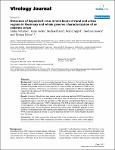Detection of hepatitis E virus in wild boars of rural and urban regions in Germany and whole genome characterization of an endemic strain
Schielke, Anika
Sachs, Katja
Lierz, Michael
Appel, Bernd
Jansen, Andreas
Johne, Reimar
Background: Hepatitis E is an increasingly diagnosed human disease in Central Europe. Besides domestic pigs, in which hepatitis E virus (HEV) infection is highly prevalent, wild boars have been identified as a possible source of human infection. In order to assess the distribution of HEV in the wild boar population of Germany, we tested liver samples originating from different geographical regions for the presence of the HEV genome and compared the detected sequences to animal and human HEV strains. Results: A total of 148 wild boar liver samples were tested using real-time RT-PCR resulting in an average HEV detection rate of 14.9% (95% CI 9.6–21.6). HEV was detected in all age classes and all geographical regions. However, the prevalence of HEV infection was significantly higher in rural as compared to urban regions (p < 0.001). Sequencing of the PCR products indicated a high degree of heterogenicity of the detected viruses within genotype 3 and a grouping according to their geographical origin. The whole genome sequence of an HEV isolate (wbGER27) detected in many wild boars in the federal state of Brandenburg was determined. It belongs to genotype 3i and shows 97.9% nucleotide sequence identity to a partial sequence derived from a human hepatitis E patient from Germany. Conclusion: The results indicate that wild boars have to be considered as a reservoir for HEV in Germany and that a risk of HEV transmission to humans is present in rural as well as urban regions.
No license information
Related Items
Show related Items with similar Title, Author, Creator or Subject.
-
2022-01-14ZeitschriftenartikelEpidemiologie der Virushepatitiden A bis E in Deutschland Dudareva, Sandra; Faber, Mirko; Zimmermann, Ruth; Bock, C.-Thomas; Offergeld, Ruth; Steffen, Gyde; Enkelmann, JuliaMit Virushepatitis A bis E werden verschiedene infektiöse Entzündungen des Leberparenchyms bezeichnet, die durch die Hepatitisviren A bis E (HAV, HBV, HCV, HDV und HEV) ausgelöst werden. Zwar ähneln sich die Krankheitsbilder, ...
-
2022-01-14ZeitschriftenartikelEpidemiologie der Virushepatitiden A bis E in Deutschland Dudareva, Sandra; Faber, Mirko; Zimmermann, Ruth; Bock, Claus-Thomas; Offergeld, Ruth; Steffen, Gyde; Enkelmann, JuliaMit Virushepatitis A bis E werden verschiedene infektiöse Entzündungen des Leberparenchyms bezeichnet, die durch die Hepatitisviren A bis E (HAV, HBV, HCV, HDV und HEV) ausgelöst werden. Zwar ähneln sich die Krankheitsbilder, ...
-
2015-07-06ZeitschriftenartikelOccult Hepatitis B Virus Infection in Nigerian Blood Donors and Hepatitis B Virus Transmission Risks Oluyinka, Opaleye O.; Tong, Hoang Van; Tien, Sy Bui; Fagbami, Ademola H.; Adekanle, Olusegun; Ojurongbe, Olusola; Bock, Thomas; Kremsner, Peter G.; Velavan, Thirumalaisamy P.Background: Occult hepatitis B virus infection (OBI) characterized by the absence of detectable HBsAg remains a potential threat in blood safety. We investigated the actual prevalence, viral factors and genotype of OBI ...

